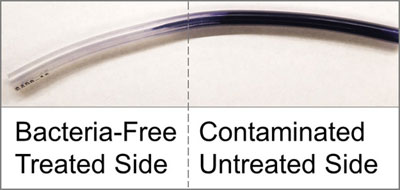Infusing liquids into polymers makes long lasting, self-replenishing material that repels deadly bacterial build-up
(BOSTON) — More than 80 percent of microbial infections in the human body are caused by a build-up of bacteria, according to the National Institutes of Health. Bacteria cells gain a foothold in the body by accumulating and forming into adhesive colonies called biofilms, which help them to thrive and survive but cause infections and associated life-threatening risks to their human hosts. These biofilms commonly form on medical surfaces including those of mechanical heart valves, urinary catheters, intravenous catheters, and implants. But a new study reported in the inaugural issue of ACS Biomaterials Science and Engineering demonstrates a powerful, long-lasting repellent surface technology that can be used with medical materials to prevent infections caused by biofilms.
The new approach, which its inventors are calling “liquid-infused polymers”, joins an arsenal of slippery surface coatings that have been developed at Harvard’s Wyss Institute for Biologically Inspired Engineering and School of Engineering and Applied Sciences (SEAS).
The technology leverages the molecular structure of polymers, which makes them highly capable of taking up and storing considerable volumes of lubricating liquids in their molecular structure, like sponges. This allows for absorption of a large reservoir of lubricant, which can then travel to the surface and render it continuously slippery and repellent — creating an environment that challenges bacteria’s ability to colonize. The team led by Joanna Aizenberg — Wyss Institute Core Faculty member, the Amy Smith Berylson Professor of Materials Science at Harvard SEAS, Professor of Chemistry and Chemical Biology in Harvard’s Faculty of Arts and Sciences, and Co-Director of the Kavli Institute for Bionano Science and Technology — is designing various such liquid-infused polymer systems.

For the current study, they have chosen a solid silicone polymer, the same kind already used in today’s medical tubing, saturated with a liquid, silicone oil. Both components are safe and non-toxic, and are already used in various medical devices and common products like cosmetics.
“The solid silicone tubing is saturated with silicone oil, soaking it up into all of the tiny spaces in its molecular structure so that the two materials really become completely integrated into one,” said Caitlin Howell, Ph.D., a Postdoctoral Researcher at the Wyss Institute and a co-author on the new findings.
It’s this saturation process that makes the liquid-infused polymer so powerful and could result in a material able to withstand conventional sterilization methods and long-lasting use. This is due to the fact that the surface does not lose its slipperiness over time — the silicone oil continuously diffuses to the surface, replenishing itself to replace any oil that is pulled away by liquids flowing against it, such as urine, blood, or gastro-intestinal fluids.
To test the liquid-infused polymer’s effectiveness in biofilm prevention, the study’s lead author Noah MacCallum, an exchange undergraduate student at SEAS, exposed treated and untreated medical tubing to Pseudomonas aeruginosa, Escherichia coli, and Staphylococcus epidermidis, which are common pathogenic bacteria that form biofilms and are frequent culprits of urinary, tissue, and blood infections. The experiment confirmed that the liquid-infused polymer tubing greatly reduced bacterial adhesion and largely eliminated biofilm formation.
As such, the new approach could be leveraged to prevent bacterial infections associated with the biofilm formation on catheters and other medical devices. This preventative aspect is crucial given that once biofilms develop they are remarkably resistant to removal, a problem that is compounded by rising antibiotic resistance in bacteria.
“With widespread antibiotic resistance cropping up in many strains of infection-causing bacteria, developing out-of-the-box strategies to protect patients from bacterial biofilms has become a critical focus area for clinical researchers,” said Wyss Institute Founding Director Donald Ingber, M.D., Ph.D., who is also the Judah Folkman Professor of Vascular Biology at Harvard Medical School and Boston Children’s Hospital and Professor of Bioengineering at Harvard SEAS. “Liquid-infused polymers could be used to prevent biofilms from ever taking hold, potentially reducing rates of infection and therefore reducing dependence on antibiotic use.”
Previously, Aizenberg and her team developed various other slippery surface technologies, including “SLIPS,” the Slippery Liquid-Infused Porous Surfaces technology introduced in 2011 that can repel virtually any liquid or solid material and offer solutions to a wide range of applications.
SLIPS inspired the invention of a different type of slippery surface using tethered-liquid perfluorocarbons, known as TLP coating, developed in collaboration between Aizenberg and Ingber in 2014. TLP coating uses FDA-approved materials to prevent bacterial build-up and sepsis from occurring due to the use of medical implants or devices, while eliminating the need for conventional and side effect-prone anticoagulant drugs.
And the most recently developed approach could also have implications beyond the medical field. “We could apply liquid-infused polymers to other materials plagued with biofouling problems, such as waste-water management systems, maritime vessels or oil pipes,” said one of the study’s lead co-authors Philseok Kim, Ph.D., who was formerly a Senior Research Scientist at the Wyss Institute and is currently co-founder and Vice President of SLIPS Technologies, Inc.
Given the recent success of the experiment, Aizenberg and her team hope the newest technology will further strengthen the impact of the portfolio of slippery surface technologies. “Each technology in our portfolio has different properties and potential uses, but collectively this range of approaches to surface coatings can prevent a broad range of life-threatening problems, from ice accumulation on airplane wings to bacterial infections in the human body,” said Aizenberg.